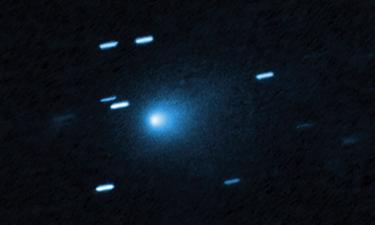Atlantis Under Antarctica?
After WW II, scientists started to pay close attention to the issue of a supposedly once-existing civilization in Antarctica. The hypothesis is confirmed by some medieval maps and research of paleogeologists and glaciologists.
In January of 1820, Lieutenant of Russian Empire Fleet Mikhail Lazarev discovered a new continent. In the beginning of 20th century, a Russian encyclopaedia, while adducing the approximate square milage of south pole continent, reported that it was insufficiently explored and there was no flora and fauna. The author of the article also mentioned the richness of the algae and sea life.
Twenty years later, the director of the Istanbul National Museum, Khalil Edkhem, was sorting out a library of the Byzantine emperors in an old palace. He found an ancient map made on gazelle skin. On the map, there were the shores of western and southern Africa, as well as the northern shores of Antarctica. Khalil could not believe hiseyes: the shores of the Queen Mod Land, to the south of the 70th parallel, was free of ice. An ancient cartographer marked a mountain chain there. The name of the cartographer was known: an admiral of the Ottoman Empire fleet, Piri Reis, who lived in the first half of 16th century.
The map’s authenticity was without doubt. Graphology examinations of the notes on the margin confirmed that they belonged to the admiral.
In 1949, a combined British and Swedish expedition conducted intensive seismic measurements of the South Pole through the ice cap. According to the commander of 8th Technical Investigation Squadron of the US Armed Force Strategic Command, Colonel Harold Olmayer, “ the geographical details of the bottom part of the map (the shore of Antarctica) correspond with the results of the seismic measurements. We cannot correlate these data with the supposed level of geography in 1513.”
In his notes on the map’s margin, made in the early 16th century, Piri Reis explained that he was not responsible for the cartography and that the map was based on earlier sources. Some of these “earlier sources” belong to his contemporaries (for example, to Christopher Columbus), while others could be dated to the 4th century B. C. Not later, because one of these sources belonged to Alexander the Great.
Of course, professional historians who specialize in ancient history could say the following: “This is only one more hypothesis. What about documentary and, what is more desirable, trust-worthy sources? The opinion of the Turkish admiral and notes on a margin… You know, it is too disputable!”
Therefore, I would like to present the position of the late historian and professor of Keene College in New Hampshire, USA, Charles H. Hapgood. In the late 1959, he found in the Washington Congressional Library a map created by Orontheus Phynius in 1531. Orontheus Phynius depicted Antarctica with mountains and rivers, without glaciers. The relief of the continent’s center was not marked, which, according to Hapgood, could mean that there had been an ice cap in that area.
In the early 1960s, Phynius’ map was studied by Doctor Richard Stratchen of the Massachusetts Technology Institute together with Hapgood. Both scientists concluded that Phynius had indeed depicted Antarctica free of ice. The characteristics depicted were very close to the information that was obtained in 1958 by specialists from different countries
Gerard Cremer, known in the world as Mercator, also trusted Orontheus’ evidence. He included the Phynius map into his atlas, in which several maps of Antarctica by Mercator himself were also included. There is one interesting feature: on Mercator’s map of 1569, the west shore of South America is pictured less accurately than on the earlier map of Mercator from 1538. The reasons for this contradiction are the following: while working at the earlier map, the cartographer of 16th century proceeded from ancient sources, which were not kept for our time, and while working at the later map, he proceeded from observations of the first Spanish explorers to South America. Gerard Mercato’s mistake can be excused. In the 16th century, there were no precise methods to measure longitude: as a rule, an error could have been hundreds of kilometers!
Finally, we come to Philippe Boiche, full member of the French Academy of Science. In 1737, he published his map of Antarctica. Boiche presented a precise picture of Antarctica of the time when the continent was free of ice. On his map, the under-ice topography of the continent is presented, about which our civilization had no clear idea until 1958. Moreover, based on now-lost sources, the French academician depicted in the middle of the South Pole a body of water dividing it into two sub-continents, which were situated to the west and to the east from the line, where the Trans-Antarctic Mountains are now marked. According to the investigation in the framework of International Geophysical Year (1958), Antarctic is in fact an archipelago of large islandscoveredwith1.5-kilometers of ice.
Medieval maps show Antarctica without an ice cap or partially covered with ice. The precision of the 16th century cartographers was very high and even surprising. Their data surpassed the technical possibilities even of the late Middle Ages (for example, the determination of the longitude of a relief within one minute). This level was reached by mankind in the late 18th century, while in some cases, the 20th.
Scientists cannot comment on the high scientific level of medieval cartography. Information from almost 2000-year-old primary sources is supposed to be not well-founded.
Orthodox geology claimed that the age of the Antarctica ice cap was at least 25 million years; however, recently, it has been reduced to six million years
Therefore, we should notice the following feature of the Reis map: the shore of the continent was free of ice. On the Phynius map, made 18 years after the Reis map, there is an ice cap around the South Pole within the limits of 80th and the 75th parallels. Two hundred years later, academician Boiche depicted Antarctica with glaciers.
The conclusion is obvious: we can see the process of the spreading of glaciers on the southern continent.
In 1949, Admiral Baird’s expedition bore holes into the Ross Sea in three spots, where Orontheus Phynius marked river-beds. In the cuts, fine-grained layers were found, obviously brought to the sea with rivers, whose sources were situated in temperate latitudes (i.e. free of glaciers).
While using the nuclear dating method of doctor U. Oury from the Karnegy Institute in Washington, scientists discovered that Antarctica’s rivers, which were sources of fine-dyspersated deposits, were flowing as depicted on the Phynius map, about 6,000 years ago. About 4000 years B. C., glacial sediments started to accumulate on the bottom of Ross Sea. Kernels show that before this, there was a long warm period.
Therefore, the maps of Reis, Phynius, and Mercator present Antarctica when the ancient Egyptian and Shumer civilizations were newborn. This point of view is excluded by almost all professional historians and could be regarded as an operating hypothesis that cannot be verified. Any historian would say that there were no civilization of the kind in the late 5th millenium B. C. According to Doctor Jacob Hock from Illinois University, the deposits in-question could be 6 to 12 thousand years old.
In September 1991, US and Egyptian archaeologists discovered at a distance of 13 km from Nile River, in Abidos, 12 large boats that belonged to Pharaohs of First Dynasty. The age of the boats is about 5,000 years. They are believed to be the most ancient vessels in the world, the leader of the expedition, D. O’Connor far, the find is estimated to be aimed for religious rites.
According to Herodotus, ancient Egyptians tracked stars more than 10,000 years ago. This statement of the “father of history” is supposed to be esoteric and, therefore, not true. However, land nations seldom produced astronomers. The fact that ancient Egyptians were interested in astronomy may indicate that they inherited some knowledge from an unknown civilization of navigators.
Workers of US technical intelligence determined the projection center of the Piri Reis map, whose data belongs to 4000 year B. C. The projection center was supposedly situated near today’s Cairo. At that time, according to most historians, all then-existing nations were at a very low level of development.
Between the 5th and 10th milleniums B. C., there was a civilization on Earth that possessed great knowledge in the field of navigation, cartography, and astronomy, which was no less advanced than that that of the 18th century.
This civilization preceded our civilization, and it was not an extraterrestrial one. Its age could be several thousands years, while its location was probably on the northern shore of the most southern continent, or archipelago: Antarctica. Later, this civilization may have resettled to the north-east of Africa.
The reason for the death of the civilization was the covering of Antarctica with glaciers. This process started no earlier not than in 10th millenium B. C. It cannot be excluded that there were also large-scale floods, which were regular and cause long-term local deluges (this is confirmed by archaeologists). These disasters could have destroyed most of the civilization’s cultural objects. However, some fragments might be found in the future under the thickness of ice. It can also be assumed that the survivors of Antarctica kept and handed down knowledge to the ancient Egyptians.
Therefore, if there will ever be an extensive exploration of Antarctica, mankind will most likely be surprised with the results.
&to=www.factor-online.com' target=_blank>www.factor-online.com
Translated by Vera Solovieva
Subscribe to Pravda.Ru Telegram channel, Facebook, RSS!





